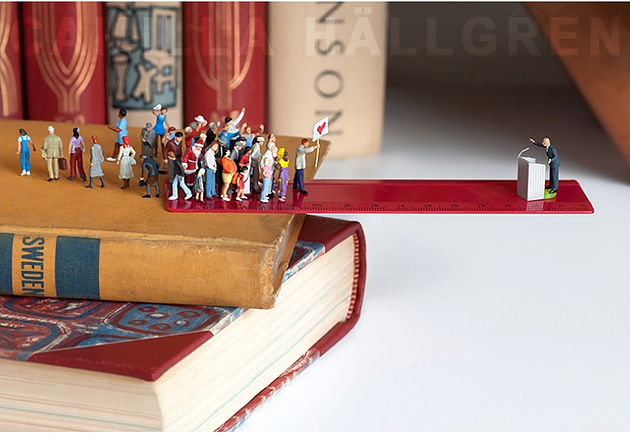WEE#RESIST: Miniaturists Confront Cultural Fears and Provide Commentary on an Unstable World
| WEE#RESIST | Gallery | Shop |
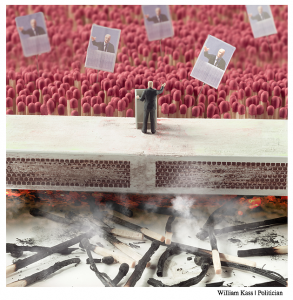 The Gallery at D. Thomas Fine Miniatures presents WEE#RESIST: Miniaturists Confront Cultural Fears and Provide Commentary on an Unstable World, an exhibition guest curated by Dr. Louise Krasniewicz (Department of Anthropology, University of Pennsylvania) that features current cultural perspectives from 12 miniaturists from across the globe.
The Gallery at D. Thomas Fine Miniatures presents WEE#RESIST: Miniaturists Confront Cultural Fears and Provide Commentary on an Unstable World, an exhibition guest curated by Dr. Louise Krasniewicz (Department of Anthropology, University of Pennsylvania) that features current cultural perspectives from 12 miniaturists from across the globe.
Miniature works of art from WEE#RESIST will be on view Sunday, June 18 through Friday, September 15, 2017 in Hastings-on-Hudson, New York. An open house reception will take place from 1-5PM on June 18 and will include an exhibit overview and discussion beginning at 3 PM. Shop hours are Tuesday through Saturday 11AM – 5PM and evenings by appointment.
The WEE#RESIST exhibition will explore the growing issues, challenges, and controversies facing all people as we move together through this period of uncertainty. The concept for WEE#RESIST was borne out of ongoing discussions of the numerous changes to the current cultural climate and world landscape and how so many presently feel powerless to affect change.
“The use of the miniature art form to enlighten, enrich, and serve as a reflection of cultural themes has existed for centuries. Miniatures compel us to focus in on a subject, explore intricacies and techniques used for their creation, and challenge us to think, question, and react” says D. Thomas Fine Miniatures owner Darren Scala.
Louise Krasniewicz (LK) described the process of curating this exhibit with Darren: “We thought a lot about the difference between a curated show and an open call to miniature artists. We decided to go with an invitational show because we wanted to focus on artists who demonstrated an interest in using miniatures as a form of political (as opposed to just aesthetic) expression. Both Darren and I scouted around for artists who were already doing this type of work and we exchanged ideas and contacts for a few weeks. We also selected some artists whose political work was not all that obvious but who created miniatures that lent themselves to the theme. We ended up pleased with the variety of media being used by the artists (metal, knitting and fabric, dioramas, photography, mosaics, mixed media) and learning about artists we had never met before.”
Darren and Louise had spoken for years about the different types of miniaturists: hobbyists, collectors, fine artists, artisans, and so on. The question that often arose was, “what do they have in common besides working with scaled objects and scenes?” Louise has always argued that miniatures (in all forms) are about creating worlds that viewers are drawn to, are invited into and can experience as an alternative to everyday reality. The artists in WEE#RESIST are doing what other miniaturists who do not think of their work as political are doing: offering a view of the world by making an object or scene that lets the viewer actually experience it rather than just look at it from the outside.
Why do you believe so strongly in this topical theme?
LK: There are all sorts of ways to resist what I see as unfair and biased ideas and actions, political stances that are hurting people, ruining the country, and not coincidentally destroying the planet. Knowing that all sorts of people are drawn to looking at miniatures, it seemed to me that making resistance art in miniature form was a perfect solution to the need to do something.
LK: I am continuing a series of movie scenes from old black and white films. These were movies I saw over and over as a kid and their aesthetic and content always influenced what I did: I suppose it will be a sort of homage to those cheesy Sci-Fi, comedy, and adventure movies we used to watch every Saturday morning. I have two Harry Potter projects in the works: the Hufflepuff Common Room which has never been seen in the movies or even described in the books; and a scene from the Department of Mysteries that is described in the books but never illustrated.
Most of my time this winter, however, was taken up with a miniature photography project using low quality mini-figures to stand in for or express human emotions or experiences. More than 5,000 photos later, and I am still not done with the project!
Anything else you’d like to add about D. Thomas Fine Miniatures?
LK: Darren Scala’s shop and gallery are the perfect places to experience the wide range of miniature possibilities, from fine art productions and exquisite artisan creations to supplies and collectibles for the miniature maker. His commitment to expanding the world is miniatures is unmatched and I hope that WEE#RESIST is seen as another effort in that direction.
—
Using a broad range of media including diorama, metal, photography, clay, and mixed media, the impressive roster of WEE#RESIST artists includes:
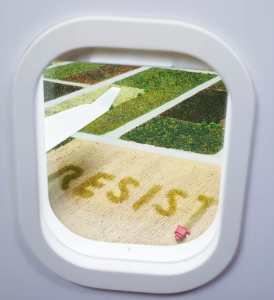 Nix + Gerber
Nix + Gerber
Lori Nix and Kathleen Gerber have collaborated on dioramas and miniatures for over fourteen years; their work has primarily been the subject matter for Nix’s fine art photography. Lori’s images of faux landscapes and gritty urban interiors have gained wide acclaim in both the U.S. and Europe, and she is a 2014 Guggenheim Fellow in photography. Their photos of miniature dioramas have graced numerous book and album covers and the duo has illustrated stories for numerous magazines. They have built miniature sets and props for videos and provided models for a video short for BBC America’s Coppers. Lori and Kathleen got their start in set building for an advertorial video for the first sustainable sushi restaurant Portland, Oregon, called “The Story of Sushi.” They continue to make large things small in the wilds of their Brooklyn apartment.
Their entry, “Flyover Country,” is a small diorama depicting the view of rural farmland with the word “resist” in a field seen from an airplane window. The viewpoint is that of the airplane passenger watching a farmer operating a combine in the field and asks the question if he is the creator of the “resist” in the field or if he going to mow down the word in opposition. “Flyover Country” provides a glimpse of a rural life that is often under-appreciated, misunderstood and may be at odds with itself and it is these beautiful and misconceived battlegrounds that are desperately needed for society to succeed. All residents of “Flyover Country” feel the brunt of the effects of many of the proposed new or modified governmental policies and they are closely connected to the land and issues concerning clean water; renewed toxic dumping by corporations; the opening up of new lands for drilling, fracking, or digging; decaying infrastructure; defunding public schools; and loss of public broadcasting will affect them more directly than those in urban environments.”
Issam Kourbaj
Kourbaj is a UK-based artist born in Soweida, Syria, which he calls “the navel of the whole human civilization” and where the revolution against the French began in 1925. Issam grew up surrounded by recycled objects such as spoons his uncle fashioned from dismantled bombs and quilts created by his grandmother from tattered cloth. “Recycled materials are embedded in my DNA,” he explains, and the use of these items are reflected in his art. He began painting in the Institute of Fine Arts in Damascus and was later accepted to the Repin Institute of Fine Arts in Leningrad (St. Petersburg). His art connects imagery to his homeland, offering a glimpse of the fragility of life and home experienced by Syrian natives and touches on words he likes including excavation, palimpsest, unearthed. “My work is about Syria without being explicitly about Syria.”
Thomas Doyle
Thomas Doyle creates sculptures rendered in 1:100 to 1:43 scale often depicting human figures beset by quiet calamities sometimes of the natural kind. Doyle’s work has been shown at museums and galleries across the US and Europe. Images of his work have appeared in various publications including The New York Times Magazine and The New Yorker. He is a recipient of the 2009 West Collection purchase prize and is a MacDowell Colony fellow. “If the Creek Don’t Rise,” Doyle’s first solo museum exhibition, was held at Hudson River Museum in Yonkers, New York in 2016.
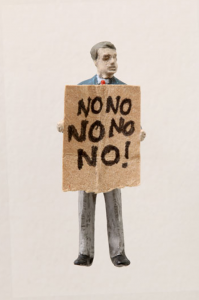 Doyle explains, “Like many Americans I am concerned about what feels like a daily erosion of the values that make America great. The people in my works take no stance on any issue, candidate, or party, but instead throw protest, anger and consumer goods into the blender of an ‘always on; communication culture where it seems everything is dialed up to 11. The path forward will be a long one, but it’s hopefully one we can travel without losing our sense of humor.”
Doyle explains, “Like many Americans I am concerned about what feels like a daily erosion of the values that make America great. The people in my works take no stance on any issue, candidate, or party, but instead throw protest, anger and consumer goods into the blender of an ‘always on; communication culture where it seems everything is dialed up to 11. The path forward will be a long one, but it’s hopefully one we can travel without losing our sense of humor.”
Pat O’Brien
A native of Kansas City for over 30 years, Pat O’Brien recently relocated to the Ozarks. A lifelong deltiologist along with her love of nature is the inspiration for her creation of “tinyescapes” for the last fifteen years. She explains, “I enjoy creating pieces that convey a story that can transport the viewer on a tiny escape.”
O’Brien’s work has been shown at a variety of galleries and art fairs in the Kansas City area. Each “tinyescape” is a diorama created with vintage postcards and model landscape materials. Subject matter ranges from fly fishing to whimsical scenes depicting hunters being stalked by bears.
O’Brien created a series of dioramas for WEE#RESIST as her personal expression of her frustration with the current White House and Administration including the building of a border wall.
William Kass
William Kass is photographer working in Brazil in advertising and visual arts; he produces authorial works based on still life photography. His current focus is the series entitled “Minimize-Food” and “Minimize-Objects” that portray unusual viewpoints of everyday life experienced by little people. He features these small characters in sets made with food and other commonplace items such as matches, candy, fresh foods, and sushi, that become integral part of a miniature world where unexpected stories take place. Kass composes each scene within the frame of his camera obtaining the perfect perspective to capture the playfully whimsical narratives. These lighthearted compositions feature the artist’s clever and imaginative way of seeing the world.
Althea Crome
Althea Crome is a self-taught fiber artist and micro knitter. Trained as a respiratory therapist, her love of knitting and her fascination with miniatures led her to her current career in conceptual miniature knitting. Althea’s inspiration comes from her love of nature and art and her work has been exhibited nationally and abroad including the Museum of Art and Design, Houston Center for Contemporary Crafts, and in private and museum collections such as the Museum Gateway Center in Kentucky and the Toy and Miniature Museum in Kansas City. Crome is a Fellow of the International Guild of Miniature Artisans and teaches regularly at the annual Guild School and in private class venues.
“In my work you will see tradition and innovation combining and merging in surprising ways. As a miniaturist, I have learned the importance of proper scale; as a knitter I have come to respect the art of traditional technique and pattern design.” Every one of Crome’s knitted miniatures is rooted in tradition, but none are mere replicas of existing patterns or styles and with a spirit of continued curiosity and a desire to create new and original pieces, she continues her pursuit for the love of knitting within the limitless possibilities of this miniature scale.
Camilla Hällgren
Camilla Hällgren is a professional artist and academic, serving as an associate professor in the department of educational science at Umea University in Sweden teaching on the graduate, master and doctoral levels. Her work reflects her focus on the intersection identity, social issues, and contemporary media and education. Since 2010 her work has been represented throughout Sweden and she is the author of numerous publications on art, education, and media.
“In my artwork, I use a combination of visual expressions and research to explore ideas about identity, social roles and power relations. I compel my art to ask: Who are we in this big world? What does it mean to be human? I work with macro techniques using 12mm model train figures and everyday items; I add crazy ideas, existentialism and theories about power, gender and identity. In short I present big issues on a small scale!”
Diana Maria Rossi
Rossi has been making mosaic sculptures for the past 28 years; she has a traditional art school background and holds a BFA degree in printmaking. Since the beginning of her mosaic career she has worked mainly in small scale with her largest mosaics to date measuring 22” x 40”, and created a public art piece at 30.5” x 25” (small for public art). “I think that I have naturally gravitated towards small scale mosaic work due to a variety of factors; rebellion against the prevailing mores of art school that ‘big is better’ and not widely questioned when I was in school; my work spaces have always been small; and I want control!!!! It is so much easier for me to control a small space.” “I like the intimacy of small — I like the idea of the viewer stumbling upon a surprise.”
“Insignificant,” Rossi’s triptych for WEE#RESIST includes three tableaux; “The World is Flat” speaks to the environment, climate change, scientific fact, and how the erosion of truth diminishes us all including the natural world. “No Body’s Hostess” tackles a woman’s right to reproductive choice and forced childbearing, while her third installment attempts to articulate feelings surrounding immigration and the position on refugees. Rossi used a combination of glass mosaic on wood with photos, text, and rose quartz marble.
Jill Orlov
Jill Orlov is a classically trained and award-winning architect, inventive artist, sculptural furniture designer, and innovative miniaturist. Her current focus is full scale furniture as well as miniatures objects and vignettes in 1/12th scale, utilizing mild steel she makes by hand along with cast metals and reclaimed objects including vintage wooden drawers, boxes, crates, plumbing parts, and other items often considered to be castaways. Orlov’s fascination with the creative process, including miniatures, began during childhood where she could be found making furnishings and accessories for her dollhouse.
During her architectural career she came to realize her favorite part of the complex design process was the making of models. “Every building I designed began with a series of scaled models and soon I came to understanding that these models were my contribution to the evolving built environment…just in miniature!” It was through enrollment in a welding class that her creative and career turning points occurred. This new-found use of metals and the processes involved in their fabrication have led to the design of a range of full size and fine scale miniatures, many depicting real life scenarios, reimagined.
In “O”, Orlov uses the letter “O” from a salvaged piece of signage to show two views of the Oval Office. Using a rotating floor, she offers views of two opposing worlds: the office of the former administration that made significant social and environmental progress represented in brushed solid steel, versus the underside, representing the current Oval Office, shown in negative space with decomposing and decaying rust. It is this overturn to the underside that is her view of the opposite of reality, the opposition and oppression resulting from many recent executive orders.
Lauren Carly Shaw
Lauren Carly Shaw is an artist living and working in Brooklyn, NY; she holds an MFA in sculpture from the San Francisco Art Institute and a BFA in sculpture from the School of Visual Arts in New York City. She participated in an international immersive contemporary studio program, Metafora, in Barcelona, where she had the opportunity to study mold making and assisted in the creation of several massive outdoor portrait projects.
Lauren’s work addresses feelings of detachment, transformation, evolution, mortality, and femininity. She uses a combination of synthetic and natural materials including plaster, silicone, cardboard, latex, and digital animation in nontraditional ways. “I am deeply interested in the human form. My work reinterprets physical elements from the human body, animals, inanimate objects, and synthetic materials. Using cast replications or constructed likenesses of the human form in conjunction with other relatable objects and materials, I make references to conditions such as scale, space, environment, and fantasy to create surreal and detached archetypes of the human form.”
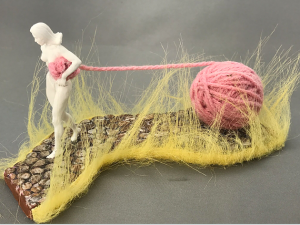 Shaw’s WEE#RESIST piece is an involved scene of 6 inch President Trump being tied down by a miniature hoard of protesters. The setting for the Gulliver’s Travels-esque downfall is a putting green where the Z-scale miniature figures emerge from all corners of the green. Making Trump larger than the masses emphasizes that our voices may be little but, when we work together, we can make change and have a great impact.
Shaw’s WEE#RESIST piece is an involved scene of 6 inch President Trump being tied down by a miniature hoard of protesters. The setting for the Gulliver’s Travels-esque downfall is a putting green where the Z-scale miniature figures emerge from all corners of the green. Making Trump larger than the masses emphasizes that our voices may be little but, when we work together, we can make change and have a great impact.
Louise Krasniewicz
Louise Krasniewicz is an award-winning photographer, miniaturist, and miniature gardener whose miniature works have recently been exhibited at the Philadelphia Flower Show, the Singapore Garden Festival, Philadelphia Miniaturia and other miniature shows, D. Thomas Fine Miniatures, The Bryn Mawr Film Institute, and the Belmar Arts Center. She is also an anthropologist at the University of Pennsylvania who studies American popular culture, fan conventions and cosplay, comic books, and movies. As both an artist and an anthropologist she is interested in worldbuilding: how people construct alternative universes that enable them to engage their imagination, creativity, and critical thinking. Her current miniature photography project utilizes low quality miniature figures to see if this imperfect form can still express human emotions and experiences. She is recently the recipient of a 2017 New Courtland Artist Fellowship which will be used to engage seniors and children in a joint miniature memory-palace project.
“Like many artists confronted with the current political situation, I did not think my small productions could make a big statement about the horrors of our cultural moment. Although I am never at a loss for ideas to create in miniature form, I was stumped about making a series of political works that moved beyond simple critique. I often let materials suggest art pieces rather than preconceiving them.” Several of her pieces created for WEE#RESIST resulted from the inspiration of fake yellow fur and include portrayal of the president giving the finger to the Constitution, the president trying to decorate King Tut’s chair in “The Boy King”; Trump in “Infinite Regress: or What Would Donald Trump See in the Mirror of Erised?” seeing only his bald head and a bit of flaming hair ad infinitum. Other works use this yellow fur as symbolic Trumpian fire: tiny women trapped in tiny bottles threatened by these yellow flames; a scene from the nuclear apocalypse movie Fail Safe with flames destroying the protective bunker; a knitter dragging her pink wool though a flaming path; silly gold men in boxes sitting on fool’s gold and comforted by the toxic flames. “The variety of my works reflects, I think, the many arenas that are being affected by this new disturbing reality that we, as artists, have to address.”
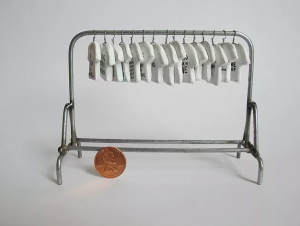 Mackenzie McAlpin
Mackenzie McAlpin
Mackenzie McAlpin resides in Philadelphia, PA and is a graduate of Ohio University with a degree in Art Photography and Retail Merchandising. A self-proclaimed “odd job kind gal,” she works as a babysitter, bookkeeper, production assistant, teaches art to children; as an artist, she works with clay and documents life through the lens of her camera. “I learned most everything I know about miniatures from my Mom, Linda; she started making minis when my siblings and I were young and after she passed away, I started sculpting miniatures and I felt like she was making them with me. Each piece is handcrafted in Philadelphia, made with love and humor just like my Mom would have done!”
For WEE#RESIST, Mackenzie has created a mini clothing rack with white tee shirts on hangers using metal wire, polymer clay, and acrylic paint. Each tee shirt will contain a single-word statement such as “EQUALITY,” “RESIST,” “PEACE”, “WOMEN,” inspired by the many protests occurring in Philadelphia and across the US.
To learn more about WEE#RESIST, visit dthomasfineminiatures.com/weeresist today. D. Thomas Fine Miniatures is a retail destination featuring artisan miniatures and top quality collectibles and where a broad array of DIY/workshops and classes are taught by master artisans. The shop also includes a gallery space exhibiting works by renowned artisans from all over the world.
